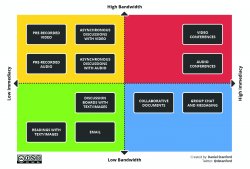Assigning collaborative learning to asynchronous courses should follow all the structural guidelines essential to any course assignment. Please visit our HAWKSync Collaborative Learning web page to review those structural elements. This page focuses on how to structure specifically for asynchronous online classes.
- Effective asynchronous online collaborative learning contains:
-
- Structure – modular, chunked content with that is preceded by a course or assignment orientation, built-in formative assessments, clear communication channels, and a consistent, but flexible schedule.
- Access to technologies and materials for all students
-

Source: Daniel Stanford
-
-
-
-
- Specific tasks – who does what and when;
- Processes/steps necessary to complete the tasks;
- Alignment to learning goals that culminates in an assessment.
- Students should be prepared and have practice in working in groups prior to any major assignments.
-
- Options for forming groups
-
-
- Random assign (instructor) – you can use Canvas Groups to help you randomly assign students to a group (ITDS training).
- Intentional assign (instructor) – using known strengths and the diverse experiences, backgrounds, and perspectives of your students, create balanced groups ahead of time.
- Self-select (students) – better for short-term, in-class group work or with more mature students.
- Group size – Michaelsen, Knight & Fink suggest 5-7 for complex tasks (bigger, long-term projects), and 2-3 for smaller tasks (single, short-term activities) (2004).
-
-
- Foster interaction early on in asynchronous classes – You should provide a means early on for students to get to know each other and practice interacting. An assigned introduction via Canvas Discussion board can break the ice:
-
-
- Discussion boards
- Sample prompt:
-
-
-
-
-
-
-
It’s a good idea to get to know each other, since we are building academic content together, sharing ideas and experiences, and doing research collaboratively. So please introduce yourself below. Here are some prompts you can use to let us know who you are, where you come from, your experiences with writing so far, and what strengths you want to build on in this course. Please respond to at least ONE of your colleagues’ posts after you have posted your own. Your response can be a comparison, something you have in common, a difference, an agreement, or a different perspective. You don’t HAVE to answer all these; they are guides to get you going: 1. Name, hometown, majors you are considering.
2. Your experiences with writing for school so far.
3. Your experiences with online learning so far.
4. The type of reading you like to do (example: sci-fi novels, social media posts, news reports, recipes, etc.).
5. If you could have a t-shirt printed with a message, it would say:
6. Four words that describe you best.
7. Something that annoys you the most.
8. Your study habits (something that works well for you or that you are trying to change to be more effective).
-
-
-
-
- Specific roles for each group member
-
Six Common Group Roles (Barkley, Major & Cross, 2014) – revised and adapted - Facilitator – Moderates all team discussions, keeping the group on task for each assignment and ensuring that everybody assumes their share of the work. Facilitators strive to make sure that all group members have the opportunity to learn, to participate, and to earn the respect of the other group members.
- Recorder – Records any assigned team activities. Recorders take notes summarizing discussion, keep all necessary records (including data sheets such as attendance and homework check-offs), and complete worksheets or written assignments for submission to the instructor.
- Reporter – Serves as group spokesperson and orally summarizes the group’s activities or conclusions. Reporters also assist the recorder with the preparation of reports and worksheets.
- Timekeeper – Keeps the group aware of time constraints, works with the facilitator to keep the group on task, and can also assume the role of any missing group member. The timekeeper is also responsible for any set-up of communication channels, and the scheduling of regular, consistent meetings or deadlines.
- Critic/Skeptic – evaluates all work for any gaps or confusing content. The critic or skeptic serves as the principal reviewer of all content developed by the group, conducts evaluation (and may create a rubric or use a rubric assigned by the instructor) of all assignments or reports before they are submitted. Checks that all criteria of the assignment has been met and raises questions or concerns about any missing or incomplete work.
- Wildcard – assumes any group member’s role or fills in however needed.
-
- Small assignments (one time or short-term)
- A discussion that involves coming to consensus on a problem or question
- Collaboratively annotating a course reading and co-writing a summary
- Co-creating a blog or wiki that generates and shares new knowledge around a course content area (research & writing)
- Large assignments (long-term, multiple tasks over several weeks)
- Creating a multimedia artifact that has a series of tasks and processes for development (videos, podcasts, digital graphics, performance);
- Co-writing a major report or presentation that requires processes of research and writing
- Facilitation
-
- How will students communicate/collaborate?
- What sort of schedule/deadlines?
- What, when, and how will they submit progress reports?
- How will they discuss and navigate working together and resolving conflicts or challenges?
- Sample contracts:
-
- Sample assignments:
-
-
-
- Team-Based Learning website
- Media assignments (Kaneb Center)
- Marketing & Communications Assignment
- More strategies (Inside Higher Ed)
- Full set of tools for all steps in developing group assignments (Carnegie Mellon)
- Full async course from UC Davis on designing assignments online.
-
-
-
- Assessing Group Work
-
-
-
-
- Progress reports (formative & summative)
- Meeting with groups (formative)
- Individual assessment (reflection paper, discussion board post, journal entry, individual progress reports)
- Group assessment (final product, meeting of staggered deadlines, evidence of collaboration)
- Peer Evaluation (confidential rating form (%), reflection on work performed -who did what?)
- Self-Evaluation (reflection of performance, areas for improvement, strengths of collaborative performance – what did I contribute? What more could I have done to improve the process and final artifact).
- Group work rubric.
- Rubrics from Carnegie Mellon.
- steps from RIT.
-
-
-
-
Updated 07.21.22 SR
